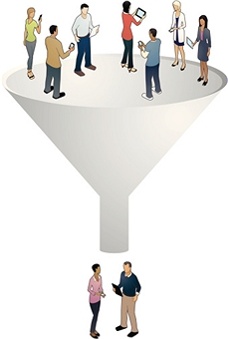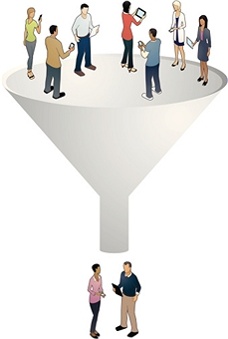
When the average person thinks about a funnel they don’t usually think about the Internet. There may be a number of different uses for the term, but largely, what often comes to mind is a tool that is wide at the top and narrow at the bottom, where a relatively large quantity of material can enter but a smaller amount can exit at the other end. The concept is similar when you’re thinking of an online marketing funnel. You want to tap into a large pool of potential customers and guide the leads through several phases until they come out the other end as viable customers. Just like in the funnel, there would be less number of customers that come out of it than the number of prospects that you start with. Learning how to do funnel marketing in our modern day world is a key component of inbound marketing.What Is a Marketing Funnel?
A marketing funnel is simply a system that tracks each phase a consumer will go through in order to become a buying customer. As a business owner, monitoring your funnel will allow you to see those areas where you need to boost your campaign efforts in order to help potential consumers to make that final decision to buy. Identifying weak spots in your funnel can help you to see exactly which strategies you need to implement in order to convert a visitor to your website into a paying customer.
The Phases of a Marketing Funnel
The phases from the broadest to the narrowest part of the funnel are as follows:
Awareness – Getting potential customers to know that your company exists.
Consideration – Getting them to consider your purchase options.
Preference – Getting them to prefer your product over others.
Action – Making the final decision to buy.
Loyalty – Keeping the customer in your fold.
Advocacy – Customers refer your business to others.
Each of these phases is extremely important in converting those leads into buying customers. Some businesses fail to consider the last two phases in their marketing funnel and stop right after the purchase. However, if your business continues to maintain a relationship with the customer after sales, you will be able to increase your return on investment substantially. Not only will you gain from repeat sales or business but you also now have an advocate who is helping you to grow even more.
How to Use a Marketing Funnel
When you’re planning your marketing campaign, your team must look at each phase of your purchase funnel and decide which actions should be taken to direct potential customers through it. These actions could be promotional campaigns designed to increase awareness, make comparisons, or outline the benefits of your product or service. As you implement each phase, you need to determine a way to measure your success so that you can make adjustments wherever needed. This could be in the form of feedback through online surveys, social media likes, or looking at statistics. This way you can successfully gauge your level of success and how your business should move forward in your marketing efforts.
An effective marketing funnel gives the business owner a snapshot of how the business is doing at every step of the campaign. As your business continues to grow, implementing a funnel can reveal many things about the health and strength of your business. The more you’re aware of these inner workings and how they relate to your customers, the better able you’ll be to grow your business and see a profitable return on your



